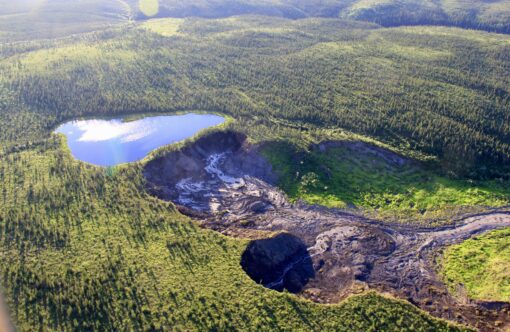Gaps in permafrost data are limiting our ability to address the climate crisis.
We currently have no integrated, strategic approach to accurately track and predict carbon emissions from thawing permafrost.
Severe monitoring gaps persist across the Arctic because data collection in these environments is challenging. Moreover, because no one entity is responsible for monitoring permafrost, scientific research across the Arctic has not been strategically coordinated or sufficiently funded. At the same time, most global models do not even include permafrost carbon, and those that do don’t account for sudden and increasingly common environmental disturbances like wildfire and abrupt thaw, which means that current estimates are likely underrepresenting permafrost carbon emissions.
By harnessing rapid advances in technology and the latest climate science, we will accelerate our understanding of the local to global impacts of permafrost thaw and provide essential data to inform climate solutions.

Locations of all eddy covariance towers in the Arctic-boreal region (open symbols). Permafrost Pathways is expanding the coverage of year-round sites that measure both CO2 and CH4 to fill critical gaps and reduce uncertainty in Arctic carbon estimates (supported towers shown in yellow, other year-round towers shown in blue). The base layer (light to dark green) shows the level of representativeness (good to poor). Map by Greg Fiske / Woodwell Climate Research Center
Monitoring
Only a handful of greenhouse gas monitoring towers across the Arctic currently run year round and measure both carbon dioxide and methane at the landscape scale, resulting in sparse and scattered data on Arctic carbon emissions. Working with a team of the world’s leading Arctic scientists, we are strategically identifying and filling carbon monitoring gaps by upgrading and installing new equipment across the Arctic in remote areas where monitoring currently doesn’t exist – an ongoing effort known as the Arctic Boreal Carbon (ABC) Flux Network. The ABC Flux Network was recently established to expand carbon flux monitoring with the explicit goal of reducing uncertainty in current and future pan-Arctic carbon budgets.
We’re coupling this on-the-ground monitoring network with high-resolution satellite observations to track the changing landscape in real-time. Together, these data will dramatically improve our estimates of permafrost emissions and remove a major barrier to their incorporation into climate policy.

Example spatial resolution of current global permafrost models (100 km) can be seen on the left, in contrast with the model being developed for Permafrost Pathways (1 km) on the right. Increasing resolution allows for more accurate and useful simulations.
Modeling
Current models of permafrost emissions have a number of deficiencies that make it challenging to develop accurate near-term forecasts and longer-term projections of permafrost thaw and carbon emissions. Working with a team of modeling experts at the University of Alaska Fairbanks, we are harnessing rapid technological advances in remote sensing and computing technology to build a data assimilation ecosystem model that will transform our ability to model permafrost emissions. These modeling systems will be built with both local and global impacts in mind—ensuring they provide actionable insights to Arctic Indigenous communities as well as international climate policymakers.
7%
of near-surface permafrost has been lost in the last 30 years due to warming (equivalent to 1.6 million km2)
106%
Increase in wildfire emissions from Alaska and Canada over the past 20 years compared to long-term records
80%
Of Arctic lands are not represented by the current year-round carbon dioxide and methane monitoring sites



